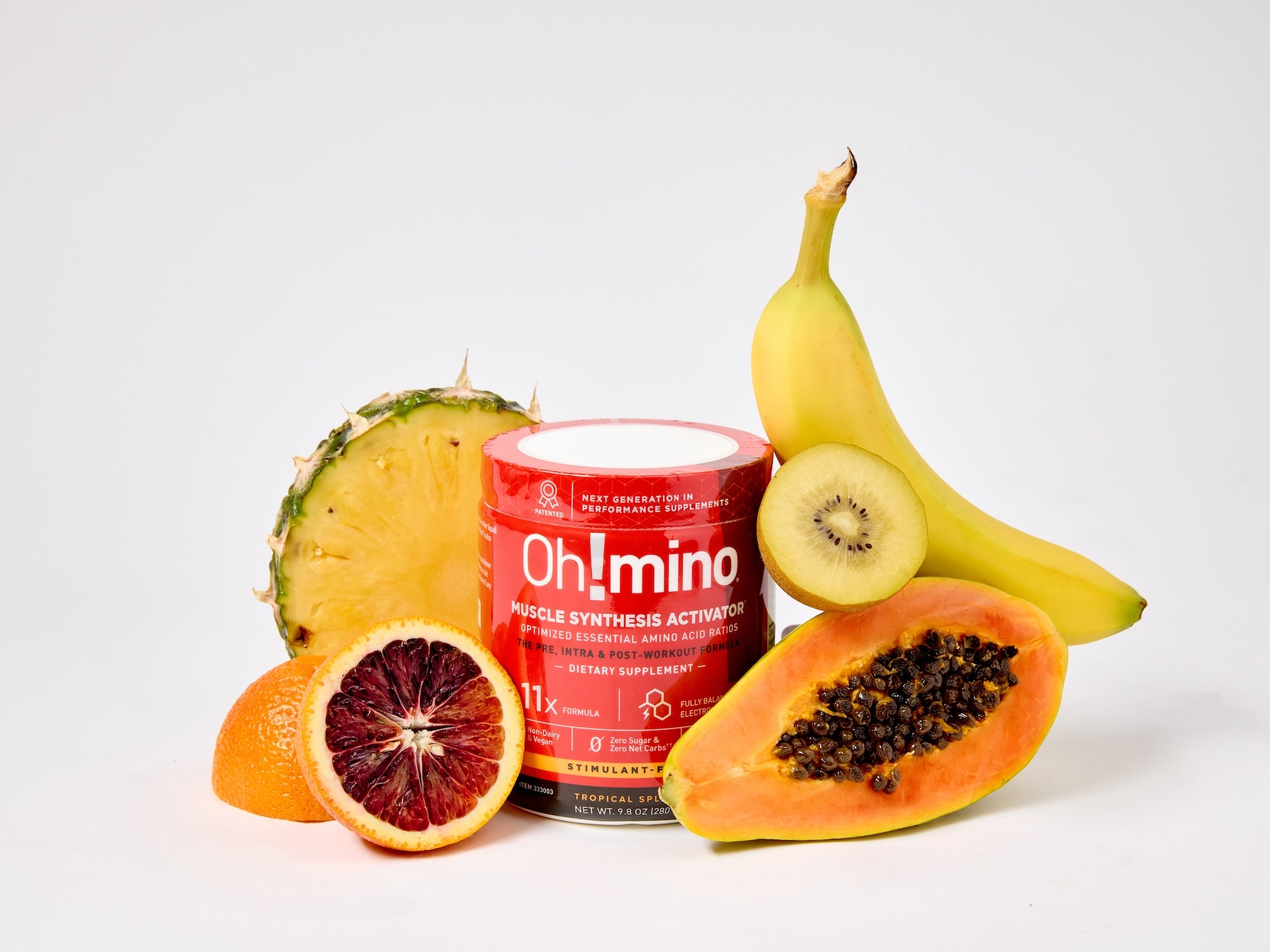Key Takeaways
-
Essential amino acids (EAAs) are vital after exercise, providing both the signal and raw materials for muscle repair and growth, working best alongside resistance training.
-
Leucine triggers protein synthesis, while isoleucine and valine support energy use and nitrogen balance; a full EAA profile maximizes recovery beyond BCAAs alone.
-
Amino acids help reduce muscle breakdown, maintain an anabolic state, and accelerate protein synthesis for faster recovery, less soreness, and improved performance.
-
Timing and dosage are key: pre-workout primes muscles, post-workout uses the anabolic window, and small doses between meals sustain recovery, especially during intense training or calorie deficits.
-
Oh!mino® Muscle Synthesis Activator delivers all nine essential amino acids, including BCAAs, in optimized ratios, boosting muscle protein synthesis, accelerating recovery, and supporting pre-, intra-, and post-workout performance.
Why Your Muscles Need Amino Acids After Exercise
Exercise, especially resistance training, causes tiny muscle fiber damage. Repairing and strengthening these fibers requires the right building blocks, essential amino acids (EAAs). Unlike other nutrients, EAAs don’t need extensive digestion to start working.
A 6 g dose of essential amino acids significantly stimulates net muscle protein balance after resistance exercise, demonstrating a dose-dependent effect on muscle protein synthesis.
Amino acids also work best alongside exercise. Combining resistance training with amino acid intake can boost muscle protein synthesis more than either alone, creating the ideal environment for repair and growth, especially when timing is right.
|
Oh!mino©: Elevate Your Performance. Accelerate Your Recovery. Science-Backed Superiority for Every Fitness Journey Power Your Goals with Proven Results:
The Oh!mino® Advantage: ✓ Patented formula that’s 11x more effective than protein, 20x more effective than BCAAs Choose Your Perfect Formula: Available in refreshing Tropical Slash or Berry Blast flavors, with stimulant-free or caffeinated options. Prefer capsules? We've got you covered with the same powerful formula. Take before, during, or after training—one solution for your entire workout. |
Essential Amino Acids That Accelerate Muscle Repair
Not all amino acids impact muscle recovery equally. Of the 20 amino acids your body uses, nine are essential, meaning they must come from diet or supplements. Within this group, some stand out for their effects on muscle repair.
Leucine: The Muscle Repair Powerhouse
Leucine is the primary trigger for muscle protein synthesis, directly activating the mTOR pathway, the “on switch” for muscle building. Research shows that Leucine-enriched essential amino acids rapidly activate the mTOR pathway, enhancing muscle protein synthesis, especially when combined with resistance exercise. Leucine also helps sustain repair, extending the anabolic window after exercise, which is why effective supplements often contain higher leucine ratios.
Isoleucine and Valine: Supporting Recovery
Isoleucine aids glucose uptake in muscles, fueling the energy-intensive repair process, while valine helps maintain nitrogen balance and prevent muscle breakdown. With leucine, these BCAAs make up roughly 35% of the essential amino acids in muscle proteins, highlighting their importance.
Other Essential Amino Acids
Beyond BCAAs, lysine supports collagen production for tendons and ligaments, while methionine acts as an antioxidant against exercise-induced stress. Research shows complete EAA formulations outperform BCAA-only supplements, as all nine essential amino acids work synergistically to maximize muscle repair.

Resistance training paired with essential amino acids maximizes muscle repair and growth.
How Amino Acids Transform Your Muscle Recovery
When amino acids enter the bloodstream, they trigger key processes that directly enhance muscle recovery. They act as both the signal and raw material for protein synthesis, making them uniquely valuable for repairing and building new muscle tissue.
Amino acids also help reduce the breakdown of existing muscle, maintaining a positive nitrogen balance and keeping your body in an anabolic (building) state.
Protein Synthesis Activation
Essential amino acids, particularly leucine, rapidly activate the mTOR pathway, turning on muscle repair and growth. EAAs stimulate protein synthesis more efficiently than even high-quality complete proteins. When combined with resistance training, amino acids create an additive effect, maximizing muscle repair and growth.
Reduced Muscle Soreness and Breakdown
BCAAs and other EAAs help lessen delayed onset muscle soreness (DOMS) and slow protein breakdown, protecting your gains during intensive training or caloric deficits.
Faster Recovery Between Workouts
Enhanced protein synthesis and reduced breakdown shorten recovery time, allowing athletes to train muscle groups 24–48 hours sooner and make faster progress toward strength and hypertrophy goals.
Enhanced Strength and Performance Gains
Consistent amino acid intake improves performance by supporting more complete recovery, leading to greater long-term strength gains, improved body composition, and sustainable training progress. Amino acids also support overall muscle metabolism, joint health, and even immune function, creating a solid foundation for continued fitness success.
Best Timing for Amino Acid Supplementation
Pre-Workout Window: Setting the Stage for Recovery
Taking amino acids before training gives your muscles an immediate pool of building blocks, allowing repair to begin as soon as muscle breakdown occurs. Pre-workout amino acids can also enhance blood flow and nutrient delivery to working muscles, improving efficiency and setting the stage for faster recovery. For best results, consume 5–10 g of essential amino acids about 30 minutes before your session to ensure peak availability during the period of greatest muscle stress.
Post-Workout: The Critical 30-Minute Window
The first 30 minutes after exercise are considered the most crucial window for recovery. Muscles are highly receptive to nutrients, and amino acid uptake is maximized. Studies show that consuming 6 g of essential amino acids immediately after resistance training can nearly double protein synthesis. Leucine within this dose triggers the mTOR pathway, optimizing muscle repair and growth. Choosing a supplement with a higher leucine ratio can further enhance this effect.
Throughout the Day: Maintaining Amino Acid Levels
Beyond targeted pre- and post-workout doses, spreading smaller 5–10 g servings between meals helps maintain a consistent anabolic environment. This steady supply supports ongoing muscle repair, prevents excessive breakdown, and is particularly valuable during intensive training or caloric deficits. For those training multiple times per day, maintaining increased amino acid levels ensures optimal recovery between sessions, allowing higher-quality performance and reducing the risk of injury.

Post-workout amino acid intake helps reduce soreness and shortens recovery time.
Optimal Amino Acid Dosages for Maximum Results
Optimizing amino acid intake depends on body weight, training intensity, and recovery goals.
Leucine: The Key Driver
For adults, leucine needs are around 14 mg per kg of body weight daily. This amino acid is central to activating the mTOR pathway, which jumpstarts muscle protein synthesis and recovery after exercise.
Other Branched-Chain Amino Acids
Isoleucine and valine requirements are about 10 mg per kg each. With leucine, they form the BCAAs, making up a major share of muscle proteins and playing crucial roles in energy and repair.
Lysine and Threonine
Lysine supports tissue repair and collagen production, with adult needs at about 12 mg per kg daily. Threonine, vital for protein balance, requires roughly 7 mg per kg.
Methionine and Phenylalanine
Methionine (with cystine) is set at 13 mg per kg, providing antioxidant protection during recovery. Phenylalanine (with tyrosine) is about 14 mg per kg, supporting neurotransmitters and protein synthesis.
Tryptophan and Histidine
Tryptophan requirements are modest at 3.5 mg per kg, helping with serotonin balance and recovery. Histidine, important for hemoglobin and tissue repair, is needed at 8–12 mg per kg daily.
Adjusting for Weight and Training
Larger individuals may need proportionally higher doses, scaling roughly 25% per 20% difference from a 180-pound reference. High-intensity or high-volume training can increase amino acid needs by 30–50%, while deload periods require standard dosing. Caloric intake also matters: supplementation around workouts may suffice in a surplus, but more frequent dosing helps preserve muscle during deficits.
Food Sources vs. Supplements: What Works Better?
The choice between whole foods and supplements comes down to convenience, absorption speed, and nutrient completeness. Whole foods provide amino acids along with vitamins, minerals, and other beneficial compounds, while supplements allow precise timing and dosing that food alone may not achieve.
Top Protein-Rich Foods
Animal proteins, eggs, dairy, meat, and fish, offer complete essential amino acids (EAAs) in ideal ratios for muscle repair, with eggs often considered the gold standard. Plant-based sources like quinoa, buckwheat, soy, and pea protein can also provide balanced amino acids when combined strategically. However, whole proteins require digestion, which can delay availability in the bloodstream during critical recovery windows.
When Supplements Shine
Supplements provide rapid absorption, with amino acids entering the bloodstream within 15–30 minutes, making them ideal around workouts. They are especially practical for early training, multiple daily sessions, or travel, and allow precise control over amino acid ratios, such as leucine-dominant BCAAs or custom EAA blends.
The Hybrid Approach
The most effective strategy combines both: use supplements pre- and post-workout for rapid recovery, and rely on whole foods for daily protein and micronutrients. This approach maximizes absorption, supports muscle repair, and maintains practicality and sustainability.
Amino Acid Supplement Types: Which Form Is Best?
Amino acid supplements come in powders, capsules, tablets, and liquids, each suited to different goals and situations. Effectiveness depends on absorption rate, convenience, and amino acid stability, helping you select the optimal form for your training and recovery needs.
Powders: Versatile and Fast
Powders mix easily with water or other beverages, allowing rapid absorption before, during, or after workouts. They offer flexible dosing, so you can adjust serving sizes based on body weight, training intensity, or recovery goals. Powders are also cost-effective for higher daily intakes and ideal for athletes who vary their supplementation schedule.
Capsules: Convenient On-the-Go
Capsules and tablets are portable and require no mixing, perfect for travel, work, or gym use. Absorption is slightly slower than powders but still faster than whole foods. The main limitation is that achieving effective doses of 10–15g EAAs often requires multiple capsules.
Liquid Aminos: Rapid Delivery
Pre-mixed liquid amino acids provide the fastest absorption, often appearing in the bloodstream within minutes. They reduce digestive discomfort sometimes associated with concentrated powders and are particularly effective immediately post-workout, when rapid delivery supports faster muscle repair.
The Ultimate EAA Formula for Muscle Growth: Oh!mino® Muscle Synthesis Activator

With added electrolytes, Oh!mino® supports hydration and endurance alongside muscle repair.
If you’re focused on strength, endurance, or overall fitness, supporting your muscles with the right amino acids at the right time is essential, and Oh!mino® Muscle Synthesis Activator makes it simple.
Complete Essential Amino Acid Formula
Each serving delivers all nine essential amino acids, including the three BCAAs, leucine, isoleucine, and valine in an optimized ratio. This composition stimulates muscle protein synthesis up to 11x more than whey protein and 20x more than standard BCAAs, accelerating recovery by up to 373%.
Clean, Low-Calorie, and Dietary-Friendly
Oh!mino® is sugar-free, carb-free, and contains no artificial fillers. At just 15 kcal per serving, it’s vegan, dairy-free, gluten-free, and non-GMO. A balanced electrolyte blend of sodium, potassium, and magnesium supports hydration and endurance.
Versatile Timing: Pre-, Intra-, and Post-Workout
-
Pre-workout: Primes muscles with amino acids and boosts energy in the caffeinated version.
-
Intra-workout: Sustains performance and delays fatigue.
-
Post-workout: Accelerates recovery, helping you train more frequently.
Flexible Options for Your Routine
Oh!mino® is available in both stimulant-free and caffeinated versions, and in powder or capsule formats. This flexibility ensures users can choose their preferred method without compromising effectiveness.
All-in-one recovery. All-in-one choice: Oh!mino®.
Frequently Asked Questions (FAQs)
Are BCAAs enough for optimal recovery?
BCAAs support muscle repair, but complete essential amino acid (EAA) supplements are more effective. All nine EAAs work together to maximize protein synthesis, accelerate recovery, and provide a complete building block profile that BCAAs alone cannot deliver.
How do amino acid supplements compare to whole foods?
Whole foods provide complete nutrition, vitamins, and minerals, but supplements deliver faster absorption and precise timing. Around workouts, amino acid supplements ensure muscles receive nutrients quickly, supporting optimal repair and reducing delayed onset muscle soreness.
Do amino acids work for endurance athletes or only strength trainers?
Amino acids benefit all athletes. Endurance athletes gain faster recovery, reduced muscle breakdown, and improved performance during long sessions, while strength athletes benefit from enhanced protein synthesis and accelerated muscle repair. Both modalities see measurable recovery advantages.
Will taking amino acids make me gain weight?
Amino acid supplements are low in calories and don’t directly cause weight gain. Combined with resistance training, they support lean muscle growth, preserve muscle during caloric deficits, and can improve body composition without unnecessary fat gain.
Is timing really that important?
Yes. Pre-workout intake primes muscles for repair, post-workout intake maximizes the anabolic window, and spacing smaller doses throughout the day maintains a positive nitrogen balance. Using a product like Oh!mino® Muscle Synthesis Activator ensures you get all nine essential amino acids at the right times to support continuous muscle recovery and reduce breakdown.





